
Kirkkonummi is a municipality of 40,983 inhabitants in southern Finland. The literal meaning of the words "Kirkkonummi" and "Kyrkslätt" in English is "church heath".

Porkkalanniemi is a peninsula in the Gulf of Finland, located at Kirkkonummi (Kyrkslätt) in Southern Finland.

St. Mary's Church, or formally the Basilica of the Assumption of the Blessed Virgin Mary, is a Brick Gothic Catholic church located in central Gdańsk, Poland. With its volume between 185,000 m3 and 190,000 m3 it is currently one of the two or three largest brick churches in the world. Only San Petronio Basilica in Bologna, comprising 258,000 m3 is larger, Munich Frauenkirche and Ulm Minster also comprise 185,000 to 190,000 m3.
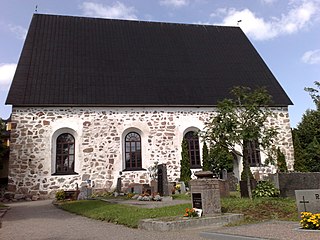
Siuntio is a municipality in the Uusimaa region of Southern Finland. Its neighboring municipalities are Ingå to the west, Kirkkonummi, to the east, Lohja to the north-west, and Vihti to the north. It is 46 kilometres (29 mi) west of Helsinki.
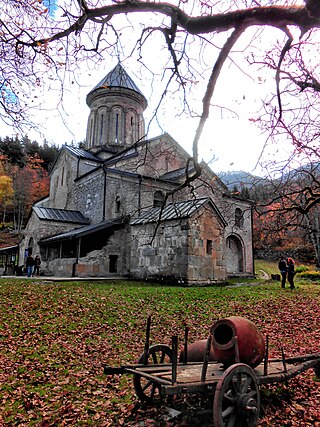
Kintsvisi Monastery is a Georgian Orthodox monastery in the Shida Kartli region, eastern Georgia, 10 kilometers from the town Kareli, on a forested slope of a high mountain of the Dzama valley. Its main church is an exceptional example of a brick church from the Georgian Golden Age period. The monumental mural is one of the largest among the Medieval Georgian artistic ensembles.

Solna Church is a so-called round church in Solna Municipality near Stockholm, Sweden. It is part of Solna Parish in the Diocese of Stockholm. The church is located on the headland between Brunnsviken and Ulvsundasjön, at the southern end of the cemetery Norra begravningsplatsen. The oldest parts of the church are from the later 12th century, a Romanesque fortress church built in stone.

Michael's Church is a church situated in central Turku. It is named after Archangel Michael and was finished in 1905. It dominates the western skyline of the city of Turku. It was designed by Professor Lars Sonck and is one of the most popular wedding churches in Turku, being able to seat 1,800 people. When Sonck won the competition for the church in 1894, he was only a 23-year-old architectural student. Michael's Church is older than Michael's parish. The parish only dates back to 1921.

St. Luke's Church is a Church of Denmark church located in the Frederiksberg district of Copenhagen, Denmark. Completed in 1897 to the design of Valdemar Koch, who also built several other churches in Copenhagen around that time, it is the second oldest church in Frederiksberg.

Muhu St. Catherine's Church, sometimes simply Muhu Church, is a medieval Lutheran church on Muhu island, in Saare County, Estonia.
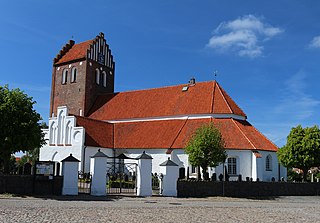
Båstad Church, also known as St. Mary's Church (Mariakyrkan), is a medieval Lutheran church built in the Romanesque style. Located in Båstad, seat of Skåne County in southern Sweden, it belongs to the Diocese of Lund.
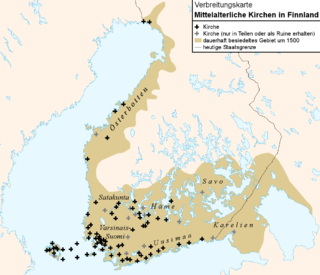
Medieval stone churches in Finland were built between the 13th and 16th century. The total number of churches was 104, of which 83 have been preserved. Numbers include the sacristies of uncompleted churches. Finnish medieval stone churches are mainly located in the western and southern parts of the country. They were usually fieldstone churches made of grey granite. Some are built of red granite and limestone while two churches are made of brick.

The Church of St. Apollinaire is located in New Town in Prague in the street Apolinarska on the hill called Vetrov. This Gothic church was built approximately between years 1360–1390. The church was established by Charles IV in 1362. Nowadays Roman Catholic Church is located here but it was administrated also by the Chemin Neuf community. The church is protected as a cultural heritage since 1958.

Lennart Rafael Segerstråle was a Swedish-speaking Finnish painter and graphic artist. He was best known for his murals and frescoes.
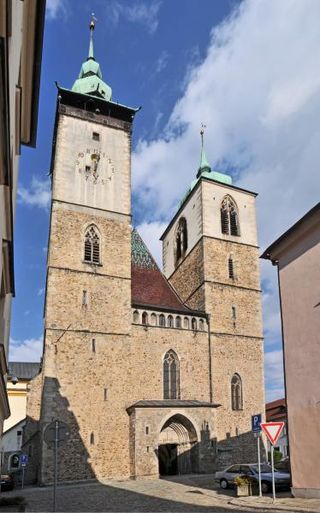
The Church of St. James the Great is an early Gothic church in Jihlava in the Czech Republic. It is a three-aisled temple nave with a long presbytery and two high towers in the front. It is consecrated to the patron of miners Saint James the Great.

St. Castulus church is a Gothic church with Romanesque and Baroque elements. It is located on the Castulus square, in Old town near Convent of Saint Agnes. It is the only church in the Czech Republic consecrated to Saint Castulus.

Siuntio St. Peter's Church is a gothic medieval stone church in Siuntio, Uusimaa, Finland, located in the old church village of Siuntio. The church is built out of grey stone between the years 1460 and 1480 next to a small stone chapel which was owned by a nearby Suitia Manor. St. Peter's Church is divided into three naves by three pairs of pilars that hold the brick vaults.

Degerby is a former Finnish municipality located in Uusimaa region in Finland. Degerby was founded in 1867 after it gained its independence from the municipality of Ingå. The municipality ceased to exist in 1945 after major part of it became a part of the Soviet naval base Porkkala.
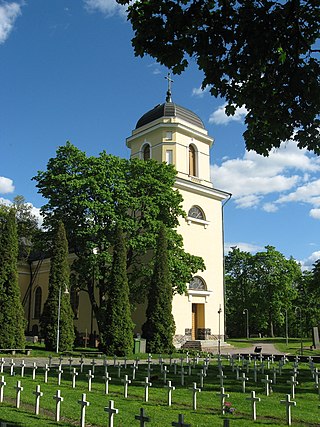
Vihti Church is a Lutheran church built in 1772 in Vihti, Finland. The church is located in Vihti church village on Hartanmäki Hill. Vihti church was constructed according to Antti Piimänen's plans. The church has been ravaged by fire twice and both times it was reconstructed. Vihti church is also sometimes referred to as Gustav's Church after Gustav III of Sweden.

Saint Nicholas Church of Ingå is a medieval church in Ingå, Finland. The church is owned by the evangelical-lutheran parish of Ingå.

Sjundby Manor is a manor house in Siuntio in Finland. The history of the manor is known from the year 1417.


























